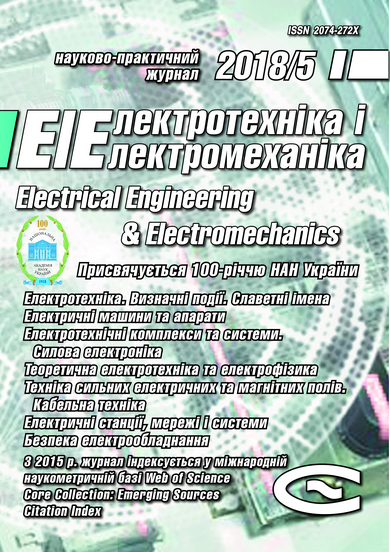ANALYSIS OF ELECTROMAGNETIC VIBRATION FORCES IN THE ELEMENTS OF THE TURBOGENERATOR STATOR FASTENING TO THE CASE IN NON-NOMINAL OPERATION MODES
DOI:
https://doi.org/10.20998/2074-272X.2018.5.05Keywords:
turbogenerator, load mode, non-nominal mode, electromagnetic force, reactive power, stator core fastening unitAbstract
Purpose. The purpose of the paper is to determine the value of additional electromagnetic forces (EMF) that are created by the fluxes of scattering of the back of the turbogenerator (TG) stator core in the elements of its fastening to the case when operating in non-nominal modes according to the vibration control data. Methodology. The paper used the theory of electromagnetic fields, the method of polynomial approximation, mathematical modeling in the MathCAD-2000 professional package and the provisions of the general theory of electrical machines. Results. Analytical and numerical calculations of additional EMF values are performed, which were created by the leakage fluxes of the back of the stator core in the elements of fastening of the TG to the case when operating in non-nominal modes, which is determined by the need for night unloading of the power system. The values of these TG forces are established with a change in the output and consumption of reactive power and with a change in voltage. Originality. For the first time for TGs operating in non-nominal modes, the estimation and calculation of additional EMF in the elements of the TG core fastening to the case are carried out, which are created by the leakage fluxes of the back of the stator core and supplement the action of the basic EMF. The definition of these forces is relevant, because turbogenerators of TPPs in Ukraine with a capacity of 200-300 MW are maneuvering capacities and solve the problem of maintaining the power factor of the power system. Practical value. It was found that if the TGs often operate in non-nominal modes, the wear of the stator core fastening systems to the case is more significant than in the case of their operation only in nominal modes. The obtained data will allow to more accurately determine the scope of repair work, draw up schedules for their implementation, determine the locations of the sensors for monitoring, and can be used at the design stage of new machines.References
1. Vaskovskyi Yu.M., Melnyk A.M. The electromagnetic vibration disturbing forces of turbogenerator in maneuverable operating conditions. Technical Electrodynamics, 2016, no.2, pp. 35-41. (Ukr). doi: 10.15407/techned2016.02.035.
2. Kuznetsov D.V. Investigation of electromagnetic forces acting on the coupling prisms of the stator core of the turbogenerator. Electricity, 2006, no.10, pp. 42-48. (Rus).
3. Stepanov A., Sikora R. Modelirovanie elektromagnitnyh polej v elektricheskih ustrojstvah [Modeling of electromagnetic fields in electrical devices].Kiev, Tehnika Publ., 1990. 188 p. (Rus).
4. Griscenko M, Vitols R. Stator core vibration and temperature analysis of hydropower generation unit at 100 Hz frequency. Proceedings of 14th International Scientific Conference Engineering for Rural Development. 20-22 May, 2015.Jelgava,Latvia, pp. 383-388.
5. Shevchenko V.V., Strokous A.V. Forecasting the operating resource of turbogenerators on vibration control data. Norwegian Journal of development of the International Science, 2017, vol.1, no.10, pp. 78-83. (Rus).
6. Minko A.N., Gordienko V.Yu. Turbogenerators with the optimal mass-size parameters in place of the exhausted resources without destroying the original foundation. Energetic and electrification, 2011, no.6, pp. 37-42. (Rus).
Downloads
Published
How to Cite
Issue
Section
License
Copyright (c) 2018 V. V. Shevchenko, A. N. Minko, A. V. Strokous

This work is licensed under a Creative Commons Attribution-NonCommercial 4.0 International License.
Authors who publish with this journal agree to the following terms:
1. Authors retain copyright and grant the journal right of first publication with the work simultaneously licensed under a Creative Commons Attribution License that allows others to share the work with an acknowledgement of the work's authorship and initial publication in this journal.
2. Authors are able to enter into separate, additional contractual arrangements for the non-exclusive distribution of the journal's published version of the work (e.g., post it to an institutional repository or publish it in a book), with an acknowledgement of its initial publication in this journal.
3. Authors are permitted and encouraged to post their work online (e.g., in institutional repositories or on their website) prior to and during the submission process, as it can lead to productive exchanges, as well as earlier and greater citation of published work.





